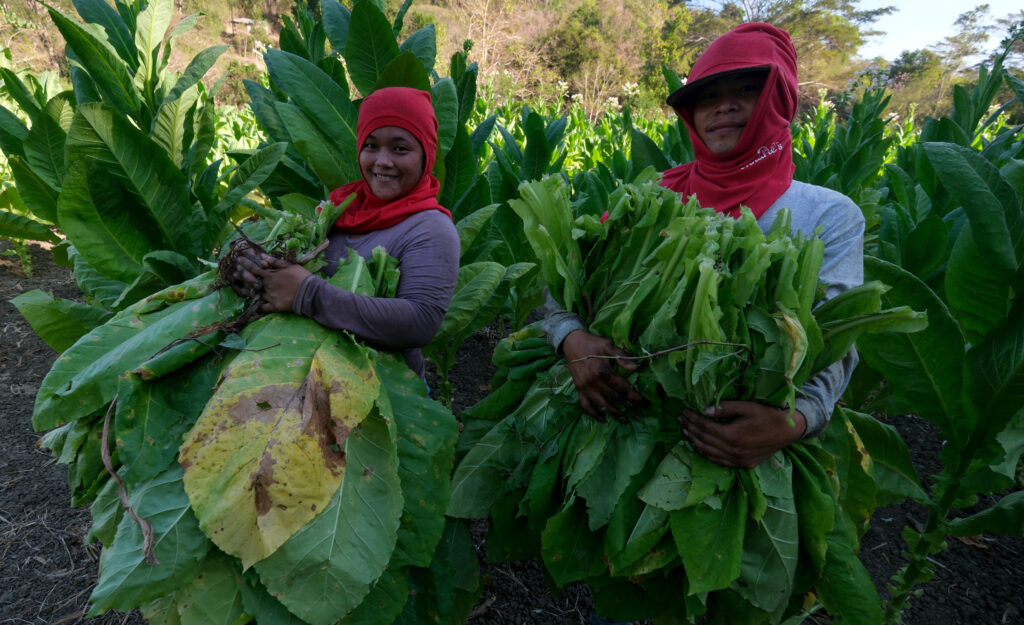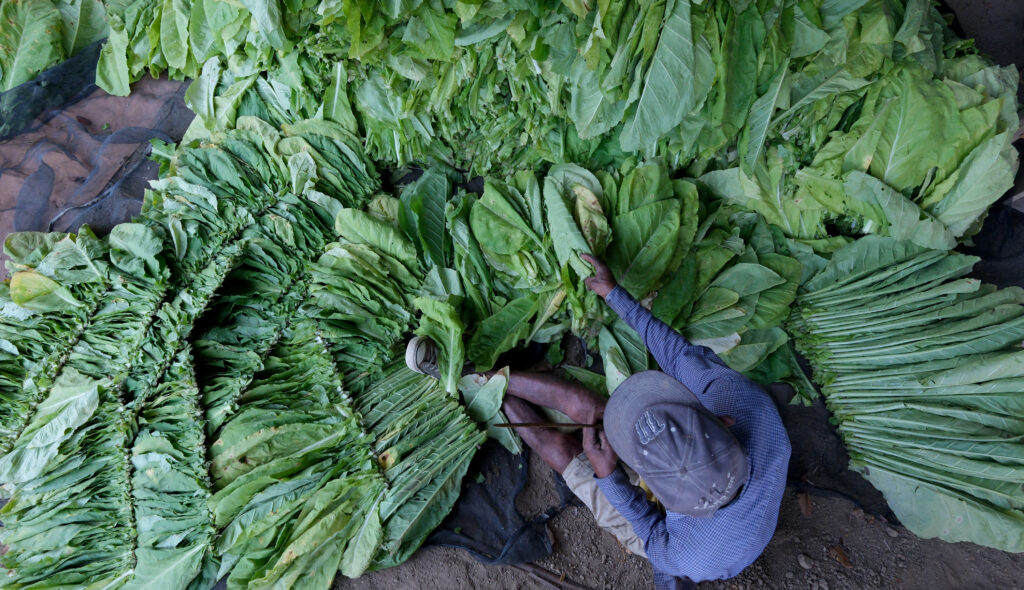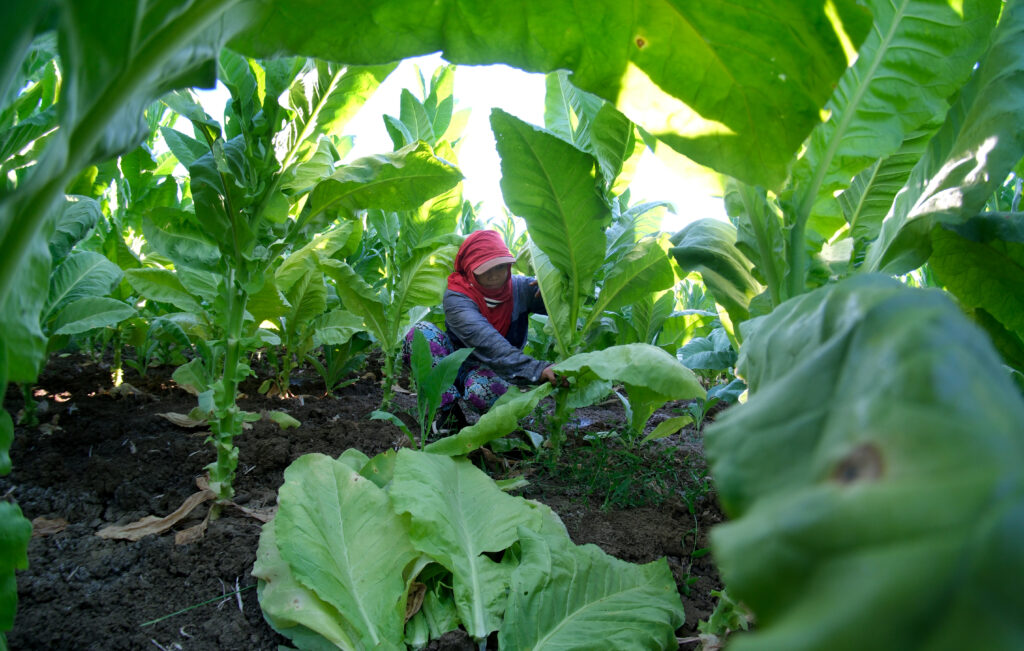By Henrylito D. Tacio
Photos by Rhoy T. Cobilla

It was Christopher Columbus, who was credited for popularizing tobacco, known in the science world as Nicotiana tabacum. After discovering America in 1521, he brought a few leaves and seeds with him back to Europe.
History records showed that tobacco was introduced into the Philippines during the era of Spanish colonization when the Augustinians brought some seeds for cultivation. In 1686, William Dampier visited Mindanao and observed that smoking was already a prevalent custom.
In the Amazon, where it originated, tobacco was used as the main curing tool of healers, according to a study published in Frontiers in Pharmacology. In fact, the Amazonian Keshwa people described tobacco as the “father of all plants.” Other natives from the area called it the “director of all medicinal plants.”
These days, tobacco carries a lot of negative baggage. Tobacco “has always had negative press,” Danny Ebelhar, an American tobacco farmer from Owensboro, was quoted as saying by Bloomberg News. “But now, it may come back to be a benefit to mankind.”
Perhaps, not too many Filipinos are aware that tobacco can drive insect pests from attacking agricultural crops. For hundreds of years, farmers in some countries used tobacco on a small scale as a natural organic pesticide.
With this in mind, a “green” pesticide industry-based could provide additional income for tobacco farmers, not to mention that tobacco can be a new eco-friendly pest-control agent.
The Florida-based Educational Concerns for Hunger Organization (ECHO) has developed two tobacco sprays against some pests and diseases. In the first tobacco spray, 250 grams of dried tobacco leaves, stems or dust are boiled in four liters of water for 20 minutes. The boiled water is allowed to cool and then filtered through layered cotton cloth. Four more liters of water are added to the solution. Fifty grams of bar soap are also added; laundry soaps are not recommended.
The solution can be poured into sorghum and corn funnels to kill stalk borers. It can also be applied as a soil drench around plants to kill cutworms. Beans can be sprayed with the solution to prevent rust disease and also to control aphids, beetles, cabbage worms, caterpillars, grain weevils, leaf miners, mites, stem borers, and thrips.
In the second tobacco spray, one kilogram of crushed or bruised tobacco stalks and leaves are soaked in 15 liters of water for 24 hours. The solution is then filtered after which three to five tablespoons of liquid soap is added. Once done, it is ready for use.
“Use this tobacco spray in the evening to allow it to work at night,” the ECHO cautions, adding that it must be sprayed on potatoes, peppers, tomatoes, eggplants, or any plant in the Solanaceae family in order to prevent the spread of viruses.
Another warning: “Do not let people or animals drink the solution, and when spraying, wear protective clothing – especially a mask, or apply solutions with a watering can only. Do not eat vegetables within four days of application and wash them carefully when you do.”
In the United States, it has been reported that some Americans grind tobacco leaves into dust or powder and make juice or tea. The liquid is sprayed onto crops. Farmers who use this technique say it keeps away flea beetles and other leaf-eating insects. It is also effective against a host of other pests, including aphids.
Still in the United States, Science Daily reported that some scientists are also converting tobacco leaves into pesticides with the technique using pyrolysis. “That process involves heating tobacco leaves to about 900⁰F in a vacuum to produce an unrefined substance called bio-oil,” the publication said.
The tobacco bio-oil was tested against a wide variety of insect pests, including 11 different fungi, four bacteria, and a potato beetle (which has become resistant to current insecticides). After the study, it was discovered that the bio-oil eliminated all of the beetles and blocked the growth of two types of bacteria and one fungus that kills eggplant, pepper, lettuce, tomato, and cucumber.
“The ability of the oil to block some, but not all of the microorganisms, suggests that tobacco bio-oil may have additional value as a more selective pesticide than those currently in use,” the study indicates.
That is good news for farmers, indeed. It is common knowledge that one of the problems with commercial insecticides is that they do not only terminate crop-eating bugs but also beneficial insects like bees, spiders, and butterflies. In most instances, through water runoff and soil leaching, pesticides make their way into rivers and lakes, causing widespread environmental damage.
One good thing about tobacco plants is that they are capable of protecting themselves from the onslaught of insects. They do so by producing cembratrienol in their leaves. Bugs are repelled by the odor of this chemical and as a result tend to stay away.
In Germany, journal Green Chemistry reported that a team from Technical University in Munich, has isolated the said chemical from tobacco leaves. “Using (the said) chemical, the scientists created a biodegradable, non-toxic and environment-friendly repellant that can be sprayed directly onto crops of all types,” wrote Ben Coxworth in New Atlas.
In laboratory tests, aphids passed over plants that were treated with the spray, going instead for untreated plants. And as a side benefit, the repellant also kills several types of gram-positive bacteria that are harmful to human beings.
“With our approach, we are opening the door to a fundamental change in crop protection,” says Prof. Thomas Bruck, who headed the study. “Instead of spraying poison, which inevitably also endangers useful species, we deliberately merely aggravate the pests.”
In the Philippines, the National Tobacco Authority (NTA) is experimenting with possible uses of by-products and wastes from tobacco after being processed.
Being biodegradable, stalks, top leaves, stems, scraps, and dusts of tobacco “are particularly appealing alternatives to synthetic pesticides and fertilizers especially during these times of high level consciousness for ‘environment-friendly’ technologies, and the fact that synthetic fertilizers and pesticides are very expensive.”
Studies conducted by NTA’s crop protection group found that tobacco scraps and waste products applied at 200 kilograms per hectare can effectively control golden kuhol, the pests that attack rice fields. This practice also increased the yield, NTA said.
The NTA is also promoting tobacco aqueous spray and tobacco dust as alternative pesticides. Tobacco spray applied at 10-days intervals can reduce the population of beanfly and bean aphids by 89% and 97%, respectively. Tobacco dust, on the other hand, can effectively kill 80 to 90% of tomato cutworm and beanfly, respectively.
Leafhoppers, thrips, and corn earthworm can also be controlled using either tobacco spray or dust. The stalks and midribs of tobacco were already proven to be excellent media for mushroom culture. In fact, this technology is already commercialized.
The NTA is also conducting some research on the use of tobacco as a source of food and feeds. It found that a very high quality protein (called fraction-1 protein) can be extracted from its leaves for human consumption. The seeds are free from nicotine and are rich in protein (25%) and oil (35%). With this finding, NTA said, “they are good sources of edible and industrial-type oils.”
Sometime in the early 1990s, NTA was able to make pastry products like polvoron, pastillas, cookies, doughnuts and pancakes with ground tobacco seeds substituting for up to 30% of the flour requirements.
In its study, NTA found that tobacco seeds can also substitute for sesame seeds or peanuts in brittle candies. Taste tests conducted on elementary pupils, high school students, college students, and professionals showed the high acceptability of these products with ratings of “liked” to “liked a lot” using the Smiley Test.
“Our future activities include the extraction, purification, and conversion of the tobacco leaf protein (fraction1-protein) into familiar food items such as cheese, gelatin, nutri-crunch (kropeck) and as a major component of beverages,” the NTA said.
As feed, tobacco seeds can substitute for 25% of the commercial feed ingredients for broilers. A study conducted on tilapia showed that up to 70% of their feeds could be substituted with tobacco seeds. As for the seed cake obtained after the extraction of the oil, it can be used as protein-rich feed for cattle and horses.
“The potential of tobacco as a source of food and feed are very promising,” the NTA said. “If fully tapped, it will not extend the usefulness of tobacco but more importantly, will be a positive factor in easing the increasing demand for food.”
But that’s not all. Tobacco stalks are woody and pliable while the midribs are pulpy. “As such, they are suitable for the manufacture of particleboard, paper, handicraft, and pulp,” the NTA said. “Being able to produce matured stalks within six months, tobacco also has the distinct advantage over the traditionally used tree species, which require about five years to become economically important.”
The NTA was able to manufacture homogeneous and three-layered types of particleboards from tobacco stalks. Both reportedly passed the standards set for commercial-type particleboards. These can be used as low cost boards for mass housing.
“Tobacco has been cultivated mainly for its leaves,” said the NTA on its website. “The very high economic returns from the leaves favored this practice, hence, neglecting the potentials of the other parts of the plant. However, with the current emphasis on the development of other products from tobacco and with the very encouraging results that we are getting, the NTA is confident of doing its share in promoting the industrialization of the countryside.” – ###


